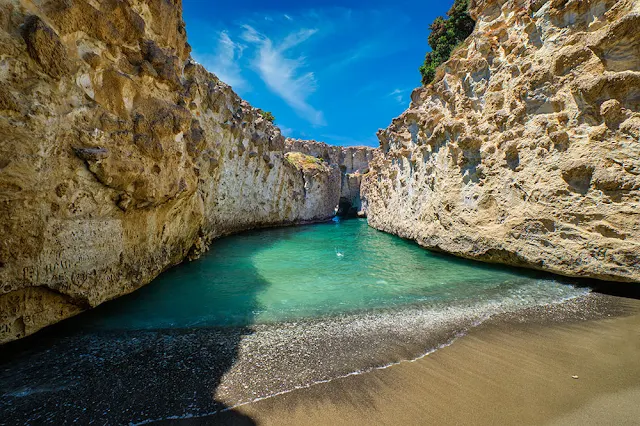Tucked away on the north shore of the enchanting Milos Island in the Cyclades, Papafragas Beach is a geological marvel and a historical site rolled into one.
This hidden gem stands out for its unique sea cave and rock formations, which serve as both a testament to the island's geological history and a window into its past.
Geological Wonder:
The defining feature of Papafragas Beach is the towering cliffs that enclose it, creating a narrow and dramatic inlet that opens into the Aegean Sea. These cliffs are primarily composed of volcanic rock, shaped by the island's tumultuous geological past. Millennia of erosion, earthquakes, and volcanic activity have carved out this breathtaking landscape.
The narrow gorge, which looks as though it was chiseled into the rock, gives way to a small pebble beach that is surrounded on all sides by the towering cliffs. It's a striking sight, and one that showcases the power of natural forces at work over eons of time.
Historical Significance:
Papafragas Beach is not only a geological marvel but also a site with historical significance. The name "Papafragas" itself has a historical connection. It is said to be derived from the Greek words "papas" (priest) and "fragas" (hole), a reference to the small sea cave within the cliffs. Legend has it that priests once used this cave as a place of refuge during pirate raids, which were not uncommon in the Aegean during the Middle Ages.
A Pirate Haven:
During the 17th and 18th centuries, the Cycladic islands, including Milos, faced the threat of piracy. These marauders would often raid coastal villages, taking people captive and plundering their possessions. To protect themselves from these attacks, the local population built fortified villages, positioned their homes in hard-to-reach areas, and even used sea caves like the one at Papafragas Beach as hideouts.
The cave at Papafragas, with its narrow entrance and rocky terrain, served as an ideal shelter for those seeking refuge from pirate incursions. The pirates' ships could not navigate the narrow opening, and it was nearly impossible for them to enter the cave. This meant that the local population could escape the pirates' clutches by retreating to such hideouts.
Visiting Papafragas Beach:
Today, Papafragas Beach is open to visitors, and while it no longer serves as a refuge from pirates, it remains a place of natural wonder and historical interest.
Here are a few tips for visiting:
- Access: To reach Papafragas Beach, you can take a short drive from the island's main town, Adamas, and follow the signs to the beach. The drive is relatively straightforward, with a small parking area near the entrance.
- Path to the Beach: A path leads down to the beach from the parking area, and it can be a bit steep and rocky in places. Visitors should exercise caution, especially when descending to the beach.
- Exploration: Spend some time exploring the sea cave, admiring the cliffs, and taking in the striking scenery. The crystal-clear waters are inviting, and the beach offers a peaceful spot for sunbathing and swimming.
- Photography: Papafragas Beach is a photographer's dream. The interplay of light and shadow on the cliffs, the turquoise waters, and the sense of history make for captivating compositions.



Comments
Post a Comment